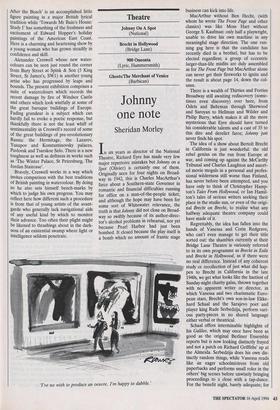Exhibitions
Ruskin Spear (Crane Kalman, till 30 April) Alexander Creswell: the Splendour of Imperial Europe (Spink & Son, till 28 April)
Narrative poems
Giles Auty
Imet the late Ruskin Spear only once, at the annual Royal Academy dinner in days when I was still invited to it, before I was effectively banned for writing adverse- ly about selection procedures for the Royal Academy Summer Show. I am no longer invited to the annual Turner Prize dinner for a similar reason. One can but presume that the properly house-trained art critic does not observe, let alone comment on, what is clearly taking place.
I suspect such evidence of extreme bureaucratic prickliness might have amused the late Ruskin Spear. His own work had a consistent edge of earthy humour which has done his posthumous reputation little good with the delightfully dour people who run the current art world. There was also a strong narrative element in many of Spear's paintings, another solecism so far as those who purport to determine art world reputations are concerned. Some see Ruskin Spear (1911-1990) historically as a kind of artistic bridge betwen Sickert and Pop. While the beneficial influence of the former's work is plain to see in Spear's work, Spear taught David Hockney, Peter Blake and others associated with the Pop art movement in turn when they were stu- dents at the Royal College.
Spear's art is quintessentially English. Walking round the charming retrospective of his paintings at Crane Kalman (178 Brompton Road, SW3), one cannot imag- ine him as a product of anywhere else than London. Like Sickert before him, Spear revelled in the everyday activities and entertainments of Londoners. He mined this rich vein through a variety of styles. While 'Conversation in a Pub', c.1950, clearly harks back to Sicken, `Backview of a Victorian House' of much the same date is treated in an entirely different manner, more reminiscent of his contemporary Carel Weight. Whether painting the sea at Gorran Haven or events or portraits derived from newspaper photographs yet another parallel here with Sickert Spear favoured a kind of spare, painterly shorthand. At his best, as in the 7ft work `Haute Couture', he was a force to be reck- oned with, although many are misled by the fact that much of his best poetry was reserved for the 4-ale bar and cheap diner. But when Spear chose to paint a formal portrait, as in that of 'Mrs Tallis', his tech- nique was equal to the test. I fear one could not say the same of many of his pupils.
Lesley Banks, who is the subject of a first big exhibition in London at Portland Gallery (9 Bury Street, St James's, SW1), is another poet of urban life — in her case of Glasgow — who has recently extended her subject matter to encompass holidays by the sea. The artist won awards in the first two years of The Spectator/Adam & Co. Art Prize in 1988 and 1989. I am delighted to see how much the promise we saw in her work has flowered. I prefer her work to that of a number of her more vaunted Glaswegian fellows in that it seems a great deal less forced or theatrical. She follows a tradition of humane and lyrical painters from Glasgow who include that excellent but still largely underrated painter of unas- suming subject matter, the late James Cowie (1886-1956). Banks paints pregnant friends and young mothers or the visual thrill of a first holiday in Cornwall, with equally disarming innocence. Pendashel: After the Beach' is an accomplished little figure painting in a major British lyrical tradition while 'Towards Mr Bain's House: Study I' has something of the freshness and excitement of Edward Hopper's holiday paintings of the American East Coast. Here is a charming and heartening show by a young woman who has grown steadily in confidence and skill.
Alexander Creswell whose new water- colours can be seen just round the corner from Bury Street at Spink & Son (5 King Street, St James's, SW1) is another young artist who has progressed by leaps and bounds. The present exhibition comprises a suite of watercolours which records the recent damage by fire of Windsor Castle and others which look wistfully at some of the great baroque buildings of Europe. Fading grandeur is a subject which can hardly fail to evoke a poetic response, but thankfully there is not the least whiff of sentimentality in Creswell's record of some of the great buildings of pre-revolutionary Russia: the Hermitage, the Lazarev, Yusupov and Konstantinovsky palaces, Pavlovsk and Tsarskoe Selo. There is a new toughness as well as deftness in works such as 'The Winter Palace, St Petersburg, The Jordan Staircase'.
Bravely, Creswell works in a way which invites comparison with the best traditions of British painting in watercolour. By doing so he also sets himself bench-marks by which to judge his own progress. You may reflect here how different such a procedure is from that of young artists of the avant- garde who generally lack navigational aids of any useful kind by which to monitor their advance. Too often their plight might be likened to thrashings about in the dark- ness of an existential swamp where light or intelligence seldom penetrate.



























































 Previous page
Previous page